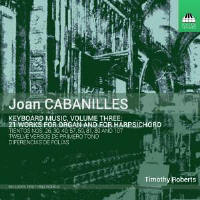Texte paru dans: / Appeared in: |
|
|
Reviewer: James
V. Maiello
With the present recording,
Timothy Roberts continues a systematic exploration of the keyboard works of
the Spanish 17th-century composer Joan Cabanilles (1644–1712). Like the
previous two discs in the series, this one contains mostly tientos and
versos, as well as several partidos and other varia; these genres were
staples of the Spanish Baroque keyboard repertoire. Again, Roberts has
chosen historical instruments, relying on a recently restored organ in the
Church of Sant Jaume, Vila-real (Castellón, Valencia) for most of the
program. Additional instruments include a reproduction of a Flemish
harpsichord and a 17th-century organ in Banyalbufar, Mallorca. Roberts
provides a brief biographical summary of the composer and notes on the
instruments used in the liner notes. These notes are augmented by an essay
by fellow scholar-organist Andrés Cea Galán that addresses issues of musical
style in the music of Cabanilles.
Much of the program consists
of premiere recordings and/or new reconstructions, making the album, like
its predecessors, a valuable addition to the discography of Baroque keyboard
repertoire. It is also worth noting that Roberts’s reconstructions are
impeccable, stylistically; they are idiomatic and consistent. Years of
experience have allowed him to internalize the flavor of this music, and he
is completely at home in this repertoire. He treats the more structured
tientos with more gravity than the freer versos, providing much needed
contrast to a somewhat monochromatic (by its nature) program. Roberts also
uses changes in registration intelligently, tying them to genre and form as
well as style. On a more interpretive level, he uses registration to create
contrast and emphasize musical details, like using trumpet stops to
highlight martial rhythms that appear, or deploying flute ones for more
subdued passages. As I mentioned in my review of the second volume, it is a real boon for listeners and students to have these works recorded by a single keyboardist. Roberts is consistent in his approach: Musical decisions are informed by a thorough understanding of Spanish Baroque music, but also of the stylistic details particular to keyboard genres and their functions, culturally. Roberts’s interpretations eschew histrionics while preserving the drama inherent in this music and in the organ as an instrument. Moreover, these performances are technically clean, and they are musical without being artificial. Such a combination of clarity, consistency, and erudition renders the entire series, from what I have experienced so far, a significant contribution to the field both as reference recordings and for general listening.
| |
|
|
|
|
|
|
|
Cliquez l'un ou l'autre
bouton pour découvrir bien d'autres critiques de CD |
|




